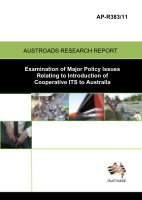Connected and Automated Vehicles

Examination of Major Policy Issues Relating to Introduction of Cooperative ITS to Australia
- Publication no: AP-R383-11
- ISBN: 978-1-921709-71-5
- Published: 17 May 2011
- PDF (free) Download
The aims of this project are to provide decision-makers with broad advice to assist them in their policy decision-making on cooperative ITS by identifying and examining the main policy issues of cross-jurisdictional scope involved with the introduction and roll-out of cooperative Intelligent transport systems (cooperative ITS) in Australia, discussing these issues under two theoretical scenarios – a market-driven and a policy-driven approach – but recognising that the preferred approach is likely to be a combination of both, comparing the scenarios and drawing out policy actions that could maximise benefits to Australia from cooperative ITS and manage any risks effectively.
- 1. INTRODUCTION
- 1.1. Purpose and Scope
- 1.2. Methodology
- 2. COOPERATIVE ITS
- 2.1. Definition and examples
- 2.2. Private and Public Interests
- 2.3. Benefit Drivers
- 2.3.1. ITS Benefit Trends
- 2.3.2. Benefit Drivers
- 3. KEY POLICY CHALLENGES TO THE INTRODUCTION AND ROLL-OUT IN AUSTRALIA
- 3.1. Dynamic and Uncertain Environment
- 3.1.1. The Issues
- 3.1.2. Overseas Experience
- 3.1.3. Some Lessons for Australia
- 3.2. Interoperability
- 3.2.1. The Issues
- 3.2.3. Some Lessons for Australia
- 3.3. Functions, Responsibilities, Liabilities and Governance
- 3.3.1. The Issues
- 3.3.2. Overseas Experience
- 3.3.3. Some Lessons for Australia
- 3.4. Privacy and Security of Information – and Personal Security
- 3.4.1. The Issues
- 3.4.2. Overseas Experience
- 3.4.3. Some Lessons for Australia
- 3.5. Human-Machine Interface (HMI)
- 3.5.1. The Issues
- 3.5.2. Overseas Experience
- 3.5.3. Some Lessons for Australia
- 3.6. Digital Mapping and Positioning
- 3.6.1. The Issues
- 3.6.2. Overseas Experience
- 3.6.3. Some Lessons for Australia
- 3.7. Communications
- 3.7.1. The Issues
- 3.7.2. Overseas Experience
- 3.7.3. Some Lessons for Australia
- 3.8. Aftermarket Applications
- 3.8.1. The Issues
- 3.8.2. Overseas Experience
- 3.8.3. Some Lessons for Australia
- 3.9. Potential for Conflict Between Commercial Applications, Network Management and Good Practice Driving
- 3.9.1. The Issues
- 3.9.2. Overseas Experience
- 3.9.3. Some Lessons for Australia
- 3.10. Roadworthiness
- 3.11. Building Consumer Confidence and Market Penetration
- 3.11.1. The Issues
- 3.11.2. Overseas Experience
- 3.11.3. Some Lessons for Australia
- 4. SUMMARY LESSONS FOR AUSTRALIA
- 4.1. Early Structured Engagement of Key Stakeholders backed by Government and Private Sector Leadership
- 4.1.1. Overseas Experience
- 4.1.2. Current Australian Position
- 4.2. Foundation Investment to Achieve Long-Term Interoperability and Avoid ad hoc Development
- 4.2.1. Overseas Experience
- 4.2.2. Current Australian Position
- 4.3. Test Sites and Pilots
- 4.3.1. Overseas Experience
- 4.3.2. Current Australian Position
- 5. SCENARIO ANALYSIS
- 5.1. Market-Driven Approach
- 5.1.1. Scenario Features
- 5.1.2. Strategic-Level Actions and Consequences
- 5.2. Policy-Driven Approach
- 5.2.1. Scenario Features
- 5.2.2. Strategic-Level Actions and Consequences
- 6. CONCLUSION
- BIBLIOGRAPHY
- APPENDIX: CONSULTATION
Related publications
AP-R654-21
Latest Connected and Automated Vehicles News
